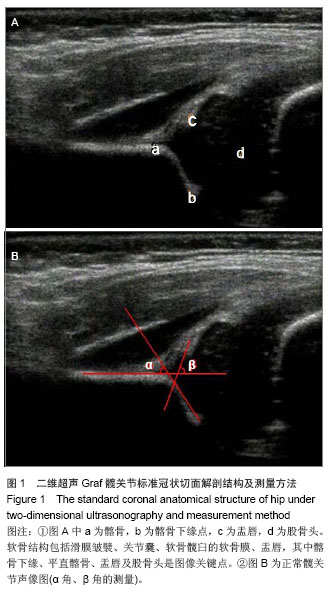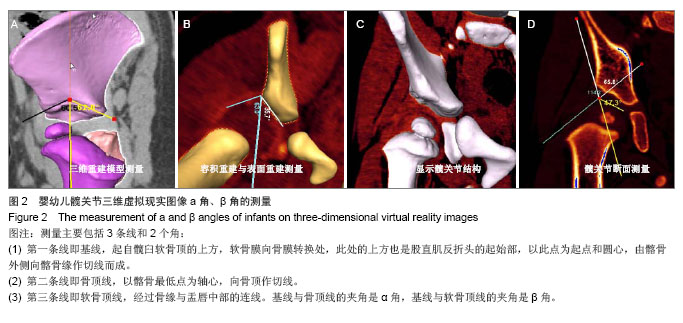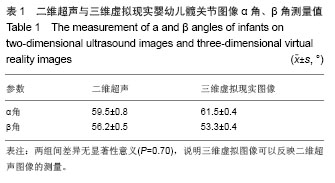| [1]刘融,张勇,张国华.术前三维可视化虚拟在发育性髋关节发育不良手术中的临床价值[J].中国现代医生,2013,51(32):51-52.[2]李文波,张文明,白国昌,等.人工全髋关节置换术治疗成人 Crowe Ⅳ型先天性髋关节发育不良伴脱位[J].中国修复重建外科杂志,2013,27(10):1153-1156.[3]Tsukada S, Wakui M. Bulk femoral head autograft without decortica- tion in uncemented total hip arthroplasty: seven- to ten-year results. J Arthroplasty. 2012;27(3):437-444.[4]Bruce WJ, Rizkallall SM, Kwon YM, et al. A new technique of subtro- chanteric shortening in total hip arthroplasty: surgical technique and results of 9 cases. J Arthroplasty. 2000; 15(5): 617-626.[5]Treiber M, Tomazic T, Tekauc-Golob A, et al. trasound screening for developmental dysplasia of the hip in the newborn: a population-based study in the Maribor region, 1997-2005. Wien Klin Wochenschr. 2008;120(1-2):31-36.[6]Graf R. New possibilities for the diagnosis of congenital hip joint dislocation by ultrasonography. J Pediatr Orthop. 1983; 3(3):354-359. [7]Azzoni R, Cabitza P. A comparative study on the effectiveness of two different devices in the management of developmental dysplasia of the hip in infants. Minerva Pediatr. 2011;63(5): 355-361. [8]Synder M, Harcke HT, Domzalski M. Role of ultrasound in the diagnosis and management of developmental dysplasia of the hip: an international perspective. Orthop Clin North Am. 2006; 37(2):141-147. [9]Felu? J, Kowalczyk B. Clinicaly silent developmental hip dysplasia--significancy of the hip ultrasonographic examination. Chir Narzadow Ruchu Ortop Pol. 2005;70(6):397-400. [10]Blatt SH. Joined at the hip? A paleoepidemiological study of developmental dysplasia of the hip and its relation to swaddling practices among indigenous peoples of North America. Am J Hum Biol. 2013 ;25(6):821-834.[11]Akiyama M, Nakashima Y, Oishi M, et al. Risk factors for acetabular retroversion in developmental dysplasia of the hip: does the Pemberton osteotomy contribute? J Orthop Sci. 2013 Oct 4. [12]黄冠兰,陈亚青.超声在发育性髋关节异常诊断中的应用[J]. 中国医学影像技术, 2009,25(4):712-715.[13]Omero?lu H, Biçimo?lu A, Koparal S, et al. Assessment of variations in the measurement of hip ultrasonography by the Graf method in developmental dysplasia of the hip. J Pediatr Orthop B. 2001;10(2):89-95.[14]Gunay C, Atalar H, Dogruel H, et al. Correlation of femoral head coverage and Graf alpha angle in infants being screened for developmental dysplasia of the hip. Int Orthop. 2009;33(3):761-764.[15]Dorn U, Neumann D. Ultrasound for screening developmental dysplasia of the hip: a European perspective. Curr Opin Pediatr. 2005;17(1):30-33.[16]李玉婵,陈博昌,张菁. 超声检查在发育性髋关节异常中的应用[J].中国矫形外科杂志,2005,13(7):538-541.[17]黄冠兰,陈亚青,超声在发育性髋关节异常诊断中的应用[J].中国医学影像技术,2009,25(7):12-714.[18]Simon EA, Saur F, Buerge M, et al. Inter-observer agreement of ultrasonographic measurement of alpha and beta angles and the final type classification based on the Graf method. Swiss Med Wkly. 2004;134(45-46):671-677. [19]陈博昌,邱勇.全国小儿髋关节与脊柱疾患学术论坛纪要[J].中华小儿外科杂志,2005,26(11):610-611.[20]黄冠兰,李銮,王莺,等.超声筛查新生儿发育性髋关节异常[J].中国医学影像技术2009,25(12):2250-2253.[21]俞波,侯艳青,严济泳.超声检查在婴幼儿发育性髋关节异常诊断中的应用价值[J].南昌大学学报:医学版,2013,53(9):9-11.[22]高树熹,蔡爱露. 高频超声与三维CT诊断婴幼儿发育性髋关节发育不良的对照观察[J]. 中国医学影像技术,2009,24(7): 1251-1254.[23]白希壮,吉士俊. Graf法超声诊断婴幼儿髋关节发育不良和脱位[J].中华外科杂志,2000,38(12):921-924.[24]Choudry Q, Goyal R, Paton RW. Is limitation of hip abduction a useful clinical sign in the diagnosis of developmental dysplasia of the hip? Arch Dis Child. 2013;98(11):862-866.[25]Sanghrajka AP, Murnaghan CF, Shekkeris A, et al. Open reduction for developmental dysplasia of the hip: failures of screening or failures of treatment? Ann R Coll Surg Engl. 2013;95(2):113-117.[26]Gulati V, Eseonu K, Sayani J, et al. Developmental dysplasia of the hip in the newborn: A systematic review. World J Orthop. 2013;4(2):32-41.[27]Talbot CL, Paton RW. Screening of selected risk factors in developmental dysplasia of the hip: an observational study. Arch Dis Child. 2013;98(9):692-696.[28]Heywood NA, Paton RW. Beware the syndrome in neonatal hip instability: follow up assessment is required after apparent resolution. Acta Orthop Belg. 2012;78(5):681-684. [29]Chen LJ, Xiong K, Wu J. Comparison of anterior chamber depth measured by anterior segment optical coherence tomography and ultrasound biomicroscopy: a meta-analysis. Nan Fang Yi Ke Da Xue Xue Bao. 2013;33(10):1533-1537. [30]尚永玲,梁倩,刘玮,等.超声筛查先天性髋关节发育不良情况分析[J].中国妇幼健康研究,2013, 24(3):330-332.[31]毕万利,武乐斌,赵鹏,等. 三维CT 在小儿发育性髋关节脱位的临床应用[J].中国医学影像技术,2007,23(5):737-740.[32]李连永,赵群. 幼儿发育性髋脱位髋臼病理形态的三维CT研究[J].中华小儿外科杂志,2005,26(11):572-575.[33]张劲松,赵黎,孙晶,等.三维CT在先天性髋关节脱位手术前后的应用[J].中国医学影像技术,2002,18(3):266-268.[34]Zajicek M, Achiron R, Weisz B, et al. Sonographic assessment of fetal secondary palate between 12 and 16 weeks of gestation using three-dimensional ultrasound. Prenat Diagn. 2013 Sep 23:1-4.[35]Kruczyński J. Magnetic resonance tomography pattern of a normal hip joint in a child and the respective pattern following trophic disturbances which resulted from treatment of developmental dislocation. Ortop Traumatol Rehabil. 2003; 5(6):741-750. [36]Wagner FV, Negrão JR, Campos J, et al. Capsular ligaments of the hip: anatomic, histologic, and positional study in cadaveric specimens with MR arthrography. Radiology. 2012; 263(1):189-198. [37]Sionek A, Czubak J, Kornacka M, et al. Evaluation of risk factors in developmental dysplasia of the hip in children from multiple pregnancies: results of hip ultrasonography using Graf's method. Ortop Traumatol Rehabil. 2008;10(2):115-130.[38]Simon EA,Saur F,Buerge M,et al.Inter-observer agreement of ultrasonographic measurement of alpha and beta angles and the final type classification based on the Graf method.Swiss Med Wkly.2004;134 (45-46):671-677.[39]Wirth T,Stratmann L,Hinrichs F.Evolution of late presenting developmental dysplasia of the hip and associated surgical procedures after 14 years of neonatal ultrasound screening.J Bone Joint Surg. 2004;86(4):585-589.[40]Rühmann O, Lazovi? D, Bouklas P, et al. Ultrasound hip joint screening in newborn infants. Is twin pregnancy a risk factor for dysplasia?. Ultraschall Med. 1998;19(2):64-69.[41]Abe Y, Sato S, Kato K, et al. A novel 3D guidance system using augmented reality for percutaneous vertebroplasty. J Neurosurg Spine. 2013;19(4):492-501.[42]Zinser MJ, Mischkowski RA, Dreiseidler T, et al. Computer-assisted orthognathic surgery: waferless maxillary positioning, versatility, and accuracy of an image-guided visualisation display. Br J Oral Maxillofac Surg. 2013 Sep 14. [43]白德明,牛建梅.超声检查在发育性髋关节发育不良诊断和治疗中的意义[J].山西医科大学学报,2001,32(2):165-167.[44]傅婵荣,徐海娜,陈萍,等.婴幼儿发育性髋关节发育不良超声筛查情况分析[J].中国农村卫生事业管理, 2013,32(9):1047-1049. [45]赵黎,刘坚林,沈品泉.婴幼儿髋关节发育不良:儿科医师如何解读超声检查?[J].临床儿科杂志,2012,30(9):898-900.[46]Grondin J, Grimal Q, Engelke K, Laugier P. Potential of first arriving signal to assess cortical bone geometry at the Hip with QUS: a model based study. Ultrasound Med Biol. 2010; 36(4):656-666.[47]Cady RB.Developmental dysplasia of the hip:definition, recognition,and prevention of late sequelae. Pediatr Ann. 2006; 35(2):92-101.[48]Vencálková S, Janata J. Evaluation of screening for developmental dysplasia of the hip in the Liberec region in 1984-2005. Acta Chir Orthop Traumatol Cech. 2009;76(3): 218-224. |


